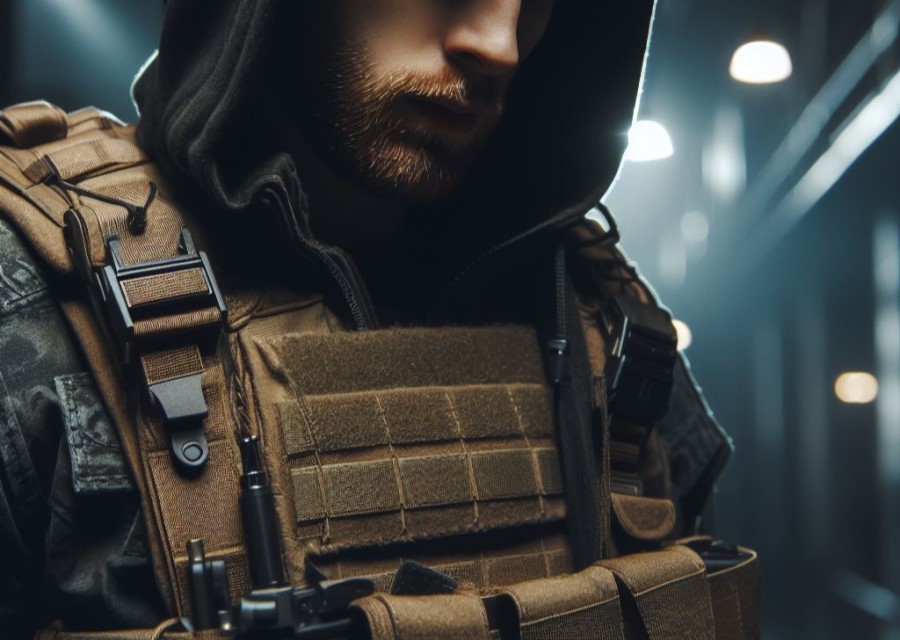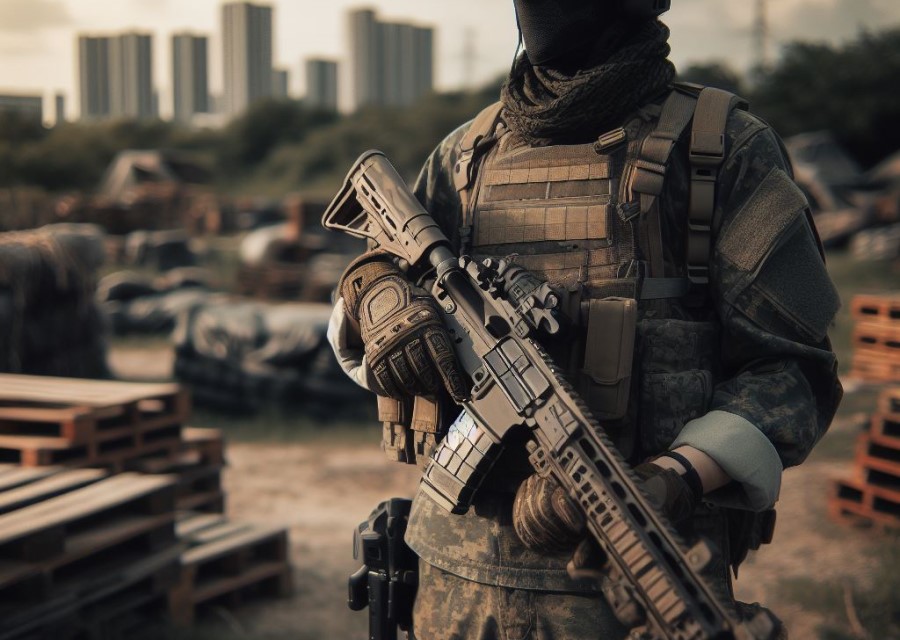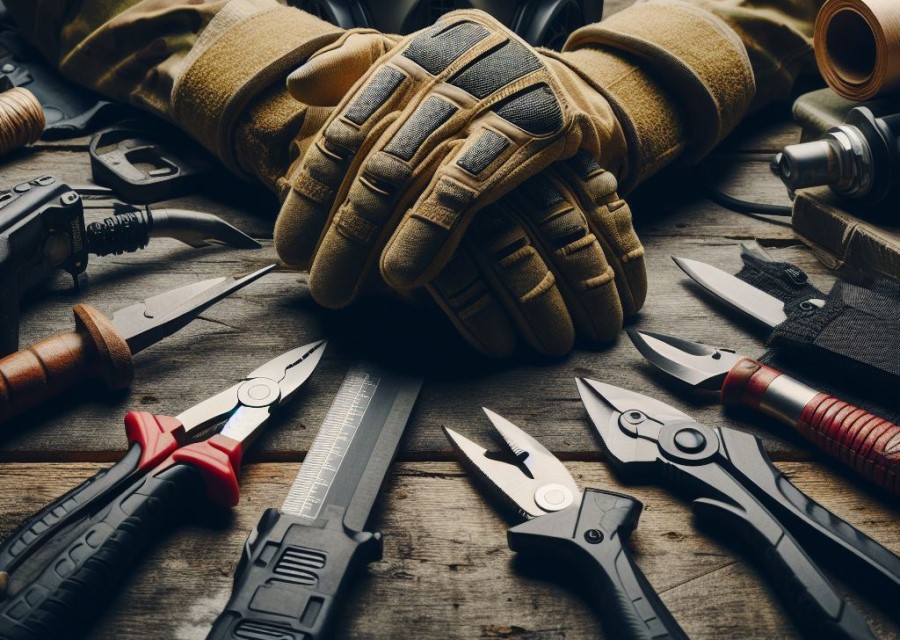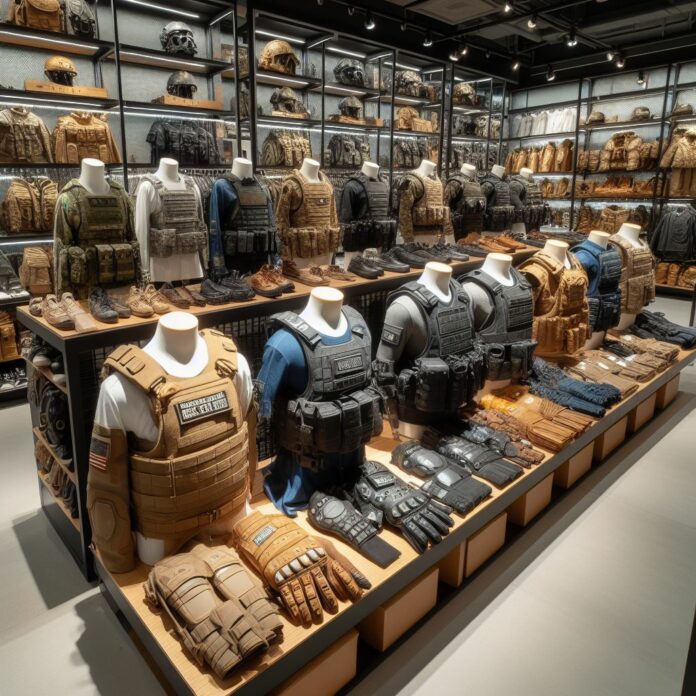Body armor classification is a significant aspect when it comes to understanding the level of protection provided by different types of body armor. It plays a crucial role in ensuring the safety and well-being of individuals in high-risk professions or situations.
By following a standardized classification system, body armor can be accurately categorized based on its level of protection and effectiveness. This classification system establishes guidelines for testing, certification, and rating of body armor, providing valuable information for individuals in need of protective gear.
Understanding how body armor classification works is essential when it comes to making informed decisions about selecting the right body armor for specific needs and requirements.
This article will delve into the intricacies of body armor classification, explore the various levels of protection, and discuss important factors to consider when choosing the appropriate body armor.
What is Body Armor?

Body armor is more than just protective gear – it’s the shield that can make all the difference. In this section, we’ll dive into the world of body armor, exploring the different types available and delving into the importance of choosing the right protection.
Stay tuned as we uncover the fascinating dynamics of body armor classification and discover why it’s crucial to understand this vital component of personal safety.
Different Types of Body Armor
Soft Armor: Consists of flexible materials like Kevlar or Dyneema and provides protection against handguns and fragments. Commonly used by law enforcement.
Hard Armor: Includes rigid plates made of materials such as ceramic or polyethylene. Offers higher protection against rifle rounds and is used by military personnel and tactical teams.
Plate Carriers: Vests or harnesses designed to hold hard armor plates. They provide additional protection to vital organs and can be customized for different missions.
Ballistic Helmets: Headgear designed to protect against projectiles and shrapnel. They provide essential protection for the head and brain.
Tactical Shields: Portable shields that offer protection against ballistic threats. They are used by law enforcement during high-risk situations.
Pro-tip: When choosing body armor, it is important to consider the specific needs of your intended use. Soft armor is suitable for everyday wear and protection against handguns, while hard armor is necessary for higher-level threats.
Plate carriers allow for customization and additional protection, while ballistic helmets and tactical shields provide vital protection for the head and other vulnerable areas. Assess your requirements and consult with experts to ensure you choose the right type of body armor for your needs.
Importance of Body Armor
The importance of body armor cannot be overstated when it comes to personal protection. In dangerous situations or occupations where there is a risk of ballistic or stab threats, wearing body armor can be a life-saving measure. Body armor provides an added layer of defense, reducing the risk of injury from projectiles or sharp objects.
Body armor is crucial for law enforcement officers, military personnel, security guards, and individuals working in high-risk environments. It offers a sense of security and confidence, allowing individuals to carry out their duties with peace of mind.
The significance of body armor lies in its ability to significantly enhance the level of safety and protection. With the right type of body armor, it can mitigate the impact of potentially lethal threats, reducing the risk of severe injury or fatality. This not only safeguards the wearer’s life but also allows them to carry out their tasks more effectively, promoting overall efficiency and proficiency.
When choosing body armor, it is important to consider factors such as the level of protection required, weight and coverage, and flexibility and mobility. These aspects ensure that the body armor meets the specific needs and requirements of the wearer in their respective roles and environments.
Pro-tip: Always invest in high-quality body armor from reputable manufacturers that comply with industry standards and undergo rigorous testing. Your safety is paramount, and compromising on the quality of body armor should never be an option.
How does Body Armor Classification Work?

Discover the ins and outs of how body armor classification really works! We’ll be diving into the intriguing realm of level-based protection, the fascinating world of NIJ Standards, and the rigorous testing and certification process.
Brace yourself for eye-opening information and get ready to unravel the mystery behind the different levels of body armor. This is the ultimate guide you’ve been waiting for!
NIJ Standard
The NIJ Standard is a crucial aspect of understanding body armor classification. The National Institute of Justice (NIJ) has established a set of standards that determine the level of protection provided by body armor. These standards ensure consistency and reliability in assessing the effectiveness of different types of body armor.
To comprehend the NIJ Standard, it is helpful to visualize the information in a table format:
| NIJ Standard | Levels of Protection | Ballistic Resistance | Stab Resistance |
| Level IIA | Lowest | 9mm FMJ RN and .40 S&W FMJ | No protection |
| Level II | Low | 9mm FMJ RN and .357 Magnum JSP | No protection |
| Level IIIA | Moderate | .357 SIG FMJ and .44 Magnum SJHP | No protection |
| Level III | High | Rifle ammunition up to 7.62mm NATO | No protection |
| Level IV | Highest | Rifle ammunition up to .30-06 M2 AP | No protection |
The NIJ Standard provides a clear framework by categorizing body armor into different levels based on the level of protection they offer. These levels range from Level IIA, which provides the lowest level of protection, to Level IV, which offers the highest level of protection against rifle ammunition. The ballistic resistance of each level is specified, indicating the type of ammunition the body armor is capable of stopping.
It is important to understand the NIJ Standard when choosing body armor as it ensures that the armor meets specific requirements for protection. By considering the level of protection needed based on potential threats and the NIJ Standard, individuals can make informed decisions when selecting body armor that suits their specific needs.
Levels of Protection
| Levels of Protection | Description | Protection |
|---|---|---|
| Level IIA | Provides limited protection and is capable of stopping low-velocity 9mm and .40 S&W ammunition. It is designed to offer basic defense. | Provides limited protection |
| Level II | Offering increased protection compared to Level IIA, Level II body armor can withstand higher-velocity 9mm and .357 Magnum ammunition. | Offers increased protection compared to Level IIA |
| Level IIIA | Providing a higher level of protection, Level IIIA body armor is capable of stopping .44 Magnum and 9mm submachine gun ammunition. | Provides higher level of protection |
| Level III | This level of protection offers superior defense against rifle rounds, including 7.62mm and .308 Winchester. It provides enhanced protection compared to Level IIIA. | Offers superior protection compared to Level IIIA |
| Level IV | Providing the highest level of protection, Level IV body armor is capable of stopping armor-piercing rifle rounds. | Provides the highest level of protection |
The levels of protection in body armor classification are as follows:
- Level IIA: This level of protection provides limited protection and is capable of stopping low-velocity 9mm and .40 S&W ammunition. It is designed to offer basic defense.
- Level II: Offering increased protection compared to Level IIA, Level II body armor can withstand higher-velocity 9mm and .357 Magnum ammunition.
- Level IIIA: Providing a higher level of protection, Level IIIA body armor is capable of stopping .44 Magnum and 9mm submachine gun ammunition.
- Level III: This level of protection offers superior defense against rifle rounds, including 7.62mm and .308 Winchester. It provides enhanced protection compared to Level IIIA.
- Level IV: Providing the highest level of protection, Level IV body armor is capable of stopping armor-piercing rifle rounds.
These levels of protection are important considerations when choosing body armor as they determine the level of defense provided against different types of ammunition. It is crucial to select a level of protection that aligns with the specific threats one may face in their line of work or activities.
Throughout history, body armor has evolved to meet the increasing threats faced by individuals. From simple designs made of animal hides to modern synthetic materials, advancements in technology have greatly enhanced the protective capabilities of body armor.
The continuous improvement in body armor classification ensures that individuals have access to the most effective and reliable protection.
Testing and Certification Process
The testing and certification process for body armor is a crucial step to ensure its performance and compliance with safety standards. This process involves several steps:
- Laboratory testing: Specialized laboratories rigorously test the body armor to assess factors such as ballistic resistance, stab resistance, and blunt trauma protection. This testing helps evaluate the armor’s performance.
- NIJ certification: The National Institute of Justice (NIJ) certification is an important part of the testing process. As an independent organization, NIJ sets the standards for body armor. To receive certification, the armor must meet the NIJ testing protocols.
- Standard compliance: The body armor is tested against specific NIJ standards that determine the levels of protection it provides against different threats. These standards serve as a framework for understanding the armor’s capabilities and limitations.
- Quality control checks: Manufacturers conduct quality control checks to ensure consistency and reliability in the production of body armor. These checks involve inspecting materials, assembly processes, and the final product to maintain a high level of quality.
- Certification labeling: Once the body armor passes all necessary tests and meets the required standards, it receives a certification label. This label provides essential details about the level of protection, the manufacturer, and other relevant information.
Overall, the testing and certification process plays a vital role in ensuring that body armor meets necessary safety standards and offers reliable protection to the wearer.
Understanding Body Armor Ratings

When it comes to body armor, understanding the ratings is crucial. Join me as we dive into the world of body armor ratings, where we’ll uncover the differences between Level IIA, II, IIIA, III, and IV. Get ready to discover the levels of protection offered by each rating and why it matters when it comes to personal safety. Let’s explore the fascinating realm of body armor classification together.
Level IIA
Body armor that meets the Level IIA standard provides excellent protection against 9mm and .40 S&W caliber bullets commonly used in handguns. This type of armor is primarily used by law enforcement officers and security personnel who face a moderate level of threat. The advantage of Level IIA body armor is its lightweight and flexible design, which allows for ease of movement and maximum comfort.
To fully understand the effectiveness of Level IIA body armor, it’s crucial to consider the standards set by the National Institute of Justice (NIJ). According to the NIJ, Level IIA armor must have the capability to stop a 9mm full metal jacket round traveling at a velocity of 1,175 feet per second, as well as a .40 S&W round at 1,020 feet per second.
When selecting Level IIA body armor, it is essential to take tactical requirements into account. This type of armor is suitable for situations where there is a moderate risk of encountering handguns. It is also important to consider the coverage and weight of the armor to ensure adequate protection while maintaining mobility and flexibility.
Level II
Level II body armor offers protection against various types of ammunition. This level of personal defense equipment can stop 9mm Full Metal Jacket Round Nose (FMJ RN), .357 Magnum Jacketed Soft Point (JSP), .40 S&W Full Metal Jacket (FMJ), .45 ACP Full Metal Jacket (FMJ), and .357 SIG FMJ pistol rounds.
The minimum velocity required for these rounds is 1175, 1395, 1155, 1060, and 1470 feet per second respectively, at a minimum distance of 5 meters. Furthermore, Level II body armor can withstand 5.56mm FMJ and 7.62mm NATO FMJ rifle rounds, which travel at velocities of 3025 and 2780 feet per second respectively, at a minimum distance of 5 meters.
It is essential to understand that Level II body armor is not designed to protect against high-velocity rifle rounds, armor-piercing ammunition, or stab and slash attacks. To ensure adequate protection, it is crucial to assess the specific threats one may encounter and choose a higher level of body armor if necessary.
Level IIIA
| Level IIIA | |
| Protection Level | Our Level IIIA body armor offers protection against most pistol calibers, including 9mm and .44 Magnum. It also provides limited protection against shotgun rounds, such as 12 gauge buckshot. |
| Ballistic Material | Usually made of multiple layers of Kevlar or similar synthetic fibers, Level IIIA body armor is woven together to form a strong and flexible barrier against ballistic threats. |
| Weight | Level IIIA body armor weighs approximately 1.5 to 2.5 pounds per square foot, depending on the specific design and materials used. |
| Flexibility and Mobility | Level IIIA body armor offers good flexibility and mobility, allowing the wearer to move comfortably during activities that require physical agility. |
Level III
| Level | Description | Protection | Threats |
| Level III | This is a high-level body armor that offers protection against rifle rounds. | Ballistic resistance against 7.62mm NATO rounds with a velocity of 2,780 feet per second. | Protection against rifle threats such as AK-47 and AR-15. |
Level III body armor is designed to provide protection against rifle rounds, specifically 7.62mm NATO rounds traveling at a velocity of 2,780 feet per second. This level of body armor offers a higher level of ballistic resistance compared to Level IIIA, which provides protection against handgun rounds. Level III body armor is capable of protecting against rifle threats such as the AK-47 and AR-15.
It is important to note that while Level III body armor provides a high level of protection against rifle rounds, it does not offer protection against armor-piercing or high-velocity rifle rounds. For enhanced protection against such threats, Level IV body armor should be considered.
When choosing body armor, it is crucial to assess the specific threats you may encounter in your line of work or activities. If your circumstances require protection against rifle rounds, Level III body armor is a suitable choice. However, it is essential to ensure that the body armor you select complies with the standards and certifications established by relevant organizations.
Level III body armor is an ideal option for military personnel, law enforcement officers, and individuals engaged in activities that involve potential encounters with rifle threats. It offers a higher level of protection and can significantly enhance personal safety in dangerous situations.
Level IV
Level IV body armor is a high level of body armor protection designed to withstand rifle rounds. It provides the highest level of ballistic protection available.
Below is a table illustrating the key details about Level IV body armor:
| Level IV | |
| Protection against: | Rifle rounds, including armor-piercing rounds |
| Ballistic material: | Ceramic or composite plates |
| Thickness: | Around 1 inch (varies by manufacturer) |
| Weight: | Varies by plate size, typically between 6 and 10 pounds |
| Protection area: | Chest, back, sides, and sometimes additional areas depending on the design and configuration |
| Commonly used by: | Military personnel, law enforcement officers, security personnel operating in high-threat environments |
Level IV body armor is designed to provide maximum protection against high-velocity rifle rounds, including armor-piercing ammunition. It is typically made of ceramic or composite materials, which can effectively absorb and dissipate the impact energy from rifle rounds.
The plates are relatively thick, around 1 inch, to provide the necessary protection. However, this also means that Level IV armor can be heavier compared to lower-level protection, typically weighing between 6 and 10 pounds.
Due to its high level of protection, Level IV body armor is commonly used by military personnel, law enforcement officers, and security personnel operating in high-threat environments. It offers vital protection against powerful rifle rounds and provides wearers with increased confidence and safety in dangerous situations.
Factors to Consider when Choosing Body Armor
When choosing body armor, there are several factors to consider. From tactical requirements to coverage and weight, and even flexibility and mobility, each aspect plays a crucial role in ensuring the right choice. Whether it’s the demands of a specific mission or the need for maximum protection, understanding these factors becomes paramount.
So, let’s dive into the key considerations that come into play when selecting body armor.
Tactical Requirements
When considering the Tactical Requirements for body armor, it is important to assess the specific needs and operational environment. This can be done by evaluating the following factors:
Combat: Choose body armor that provides a high level of protection, such as Level IIIA or Level III. This will offer defense against common ballistic threats encountered in combat situations.
Law enforcement: Consider body armor that allows for ease of movement and flexibility, such as lightweight vests. This will enable law enforcement personnel to perform their duties effectively without compromising safety.
Tactical operations: Select body armor that offers maximum coverage without hindering mobility. This can include options like modular systems, which allow for customization based on the specific mission requirements.
Specialized units: Specialized units, like SWAT teams or bomb disposal units, may require body armor with additional features, such as integrated communication systems or protection against specific threats like stabbings or explosions.
Climate: Consider the climate where the body armor will be used. In hot environments, choose breathable materials and lightweight designs to prevent overheating. In colder climates, opt for insulation and layering options.
By carefully considering the Tactical Requirements of the intended use, individuals can select body armor that provides the necessary protection and functionality for their specific needs.
Coverage and Weight
When considering body armor, it is important to take into account the factors of coverage and weight. The level of coverage offered by the armor ensures that vital areas are protected, while the weight determines the comfort and mobility of the wearer.
- Coverage: The extent of coverage provided by body armor varies depending on the type and level of protection. It is essential to choose armor that covers critical areas such as the chest, back, and vital organs. The level of protection desired will determine the amount of coverage needed.
- Weight: The weight of body armor can significantly impact the wearer’s comfort and mobility. Lighter armor allows for increased agility, flexibility, and ease of movement. It is crucial to find a balance between weight and protection to ensure the armor is both effective and comfortable to wear.
When selecting body armor, it is essential to consider the level of coverage necessary for the intended use and the weight that allows for optimal performance. This will ensure that the armor provides adequate protection while allowing the wearer to move freely and comfortably.
Flexibility and Mobility
When considering body armor, flexibility and mobility is of utmost importance in making the right choice. Factors to take into account include:
- Range of motion: The flexibility of body armor plays a critical role in allowing you to move freely. Opt for armor that offers a wide range of motion, enabling you to efficiently carry out tasks without any hindrance.
- Weight distribution: Body armor should evenly distribute its weight to prevent strain on specific areas of your body. Make sure that the armor is designed to distribute weight evenly and does not put excessive pressure on particular body parts.
- Comfort and fit: It is essential to select body armor that fits well and is comfortable to wear for extended periods. Consider features like adjustable straps, padding, and ergonomic design to enhance comfort and minimize discomfort during prolonged use.
- Compatibility with equipment: Ensure that the chosen body armor does not restrict or interfere with the use of other tactical equipment, such as communication devices or weapons. The armor should easily accommodate any additional equipment.
- Affordance of movement: Body armor should not hinder your ability to run, crouch, kneel, or perform other essential movements required for tactical operations. It should enable quick and smooth movements, enhancing overall mobility and response time.
Taking these factors into consideration will assist you in selecting body armor that offers optimal flexibility and mobility. This will enable you to effectively fulfill your duties while ensuring your safety and protection.
Frequently Asked Questions
How does body armor classification work?
Body armor classification is based on the National Institute of Justice (NIJ) standards, which include different levels of protection based on the type of threats. These levels range from Level IIA to Level IV.
What is back face deformation in body armor?
Back face deformation refers to the indentation created on the surface of body armor when it is hit by a projectile. It is an important factor in evaluating the effectiveness of the armor, as excessive deformation can cause injury to the wearer.
What is the role of the U.S. Department of Justice in body armor standards?
The U.S. Department of Justice, specifically the National Institute of Justice (NIJ), is responsible for setting and testing the ballistic protection standards for body armor. They conduct rigorous testing to ensure the integrity and effectiveness of body armor products.
How are special regional threats considered in body armor standards?
Body armor standards in different countries, such as the VPAM standard in Europe and the TR standard in Germany, take into account special regional threats by specifying different protection levels against specific projectiles commonly encountered in those regions.
What is the importance of spike protection in body armor?
Body armor with spike protection is designed to provide defense against weapons with pointed tips, such as knives and needles. This is especially important in law enforcement situations where officers may face these types of threats.
Is there body armor specifically designed for women?
Yes, there are body armor options specifically designed for women. These options consider the anatomical differences between men and women to provide a better fit and comfort for female users.

